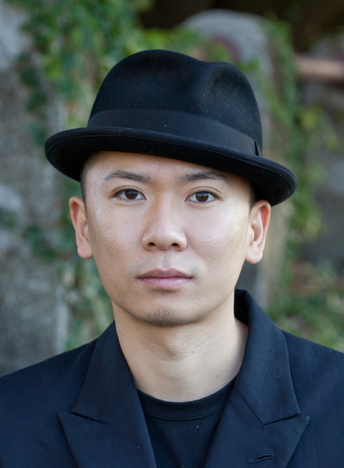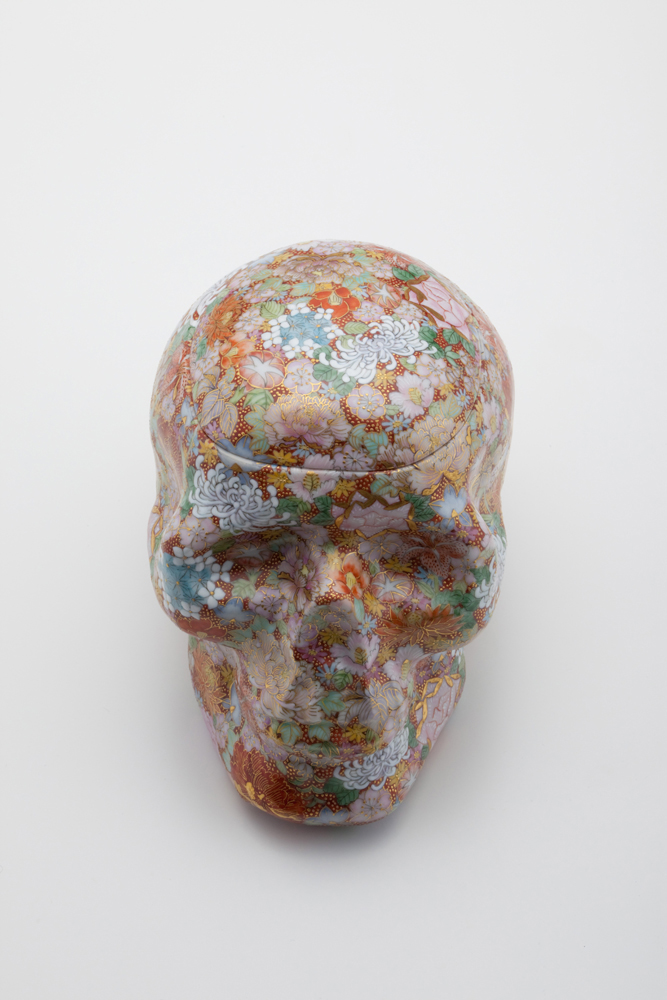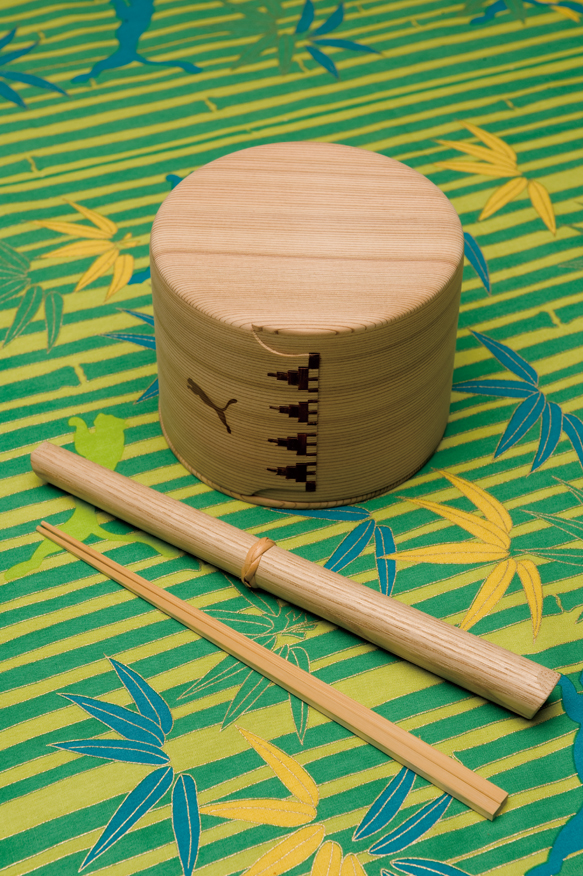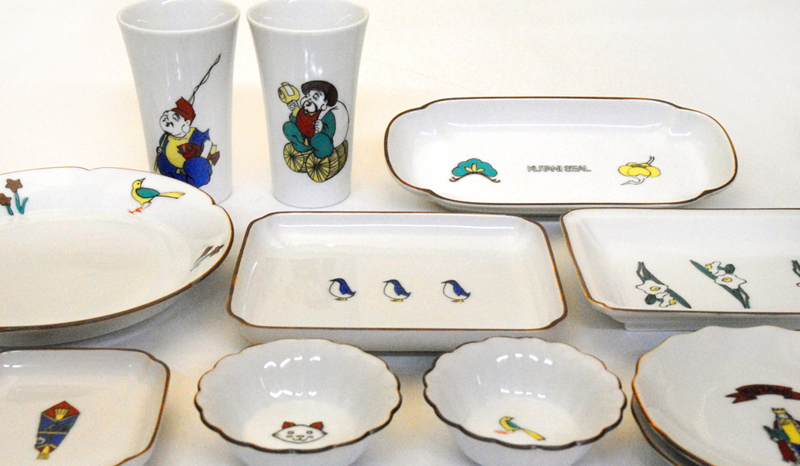MARUWAKAYA
January 2010—The Kamide Kutani Keigo Exhibition, “KUTANI CONNEXION” (Spiral, Omotesando) and “Medicine and Art” (Mori Museum, Roppongi) are some of the exhibits for which Kamide Choemongama‘s Kamide Keigo is garnering attention. At the center of this effort to revive Japanese traditional crafts for the contemporary crowd from a new perspective is the young producer Maruwaka Hirotoshi, the representative of Maruwakaya. At DESIGNTIDE 2009, he unveiled “otsuriki“, an iPhone case co-designed with Asakusa artisans using inden, a Japanese craft of lacquer printing on deer skin, which is an art dating back several centuries. He is responsible for spreading the Maruwakaya name. Describing himself as a folk crafts otaku or geek, Maruwaka spoke of his passion towards monozukuri, or the art of making and creating.

© Maruwaka. Photo: Koichiro Kutsuna
At Maruwakaya, simple repetition is not considered tradition, but the development of something new through the repetitive process is, in fact, tradition. Based on this concept, you attempt at monozukuri. You are also very aware of “monozukuri by creators with responsibilities”. Can you tell us more about this?
“Monozukuri by creators with responsibilities” is simply this. Usually, different sections have different responsibilities. For parts outside of one’s assigned section, people avoid responsibilities by making excuses: “I’m not in charge of this” or “I have to ask my boss”. When we hear these excuses, I think we all feel the same way; it doesn’t feel good. It’s like watching politicians on TV making vague comments in order to evade accountability. For example, notices and warning labels are actually exits or escape routes for avoiding trouble. I think this is also very true in monozukuri. That’s why it is important for traditional crafts, the creators especially, to think of the next person or the person who will be using the finished product. What I found through speaking with artisans is that they say things like, “we can’t make something like that” and are genuinely stubborn, because by taking on tall orders, the artisans can’t promise to deliver, and they don’t know if they will be able to hold their heads up to their brand or towards their customers. This is their obstinacy. Stubbornness, for most people, simply connotes inflexibility or lack of imagination, but I think that coming to that conclusion is just a way of avoiding responsibility by relying on the word “stubbornness”. On the other hand, creators must also constantly challenge themselves, and to master their craft and to overcome obstacles in order to create something good. I think both sides are lopsided. The easiest way to rid of this imbalance is to take responsibility. That is what I mean by “creators taking responsibilities”. Also, we, as users, must also take responsibilities.
How did you get involved in traditional crafts?
I was introduced to Kutaniyaki through some people, and that was my starting point. I was already interested in handiwork and Japanese culture, and was strongly drawn to the field. I would look at something Japanese the way most children may be interested in superheroes. At the time, I was not able to conceptualize whether something was old or new, if it was something artificial or cultural, but I just knew if something was hot or not. Back then, these objects were hotter than superheroes for me, simply put. As I grew up, I found out that Japaneseness was actually in our DNA, and that actually shocked me—to learn that my own ancestors, how many ever generations back, wore their hair in samurai-style. I felt that it would be a waste to end this ancestral line.

“skull” Photo: Koichiro Kutsuna
You probably have a stronger aptitude or sensitivity towards Japanese culture that led you to work in this field. All Japanese people have this “DNA”, but what do you think is different about you that made you this active in disseminating such tangible ideas.
I grew up in Yokohama’s Chinatown. I was always in a multinational environment. Even as a child, I was very conscious about Japanese people. I think foreign cultures are fantastic. But there is no doubt in my mind that Japanese culture should be considered any less than other cultures. And yet, young people of my generation in Japan turned towards the latter. I was very suspicious of this. I have never lived abroad, but since I grew up in a multinational environment, I have no inferiority complexes or hang-ups regarding foreigners. I recognize that foreigners can look very cool. But if they wore their hair in samurai-style, they probably won’t look too cool (laughs). That’s why I think there is a Japanese coolness, which I think can be a significant international standard. Even if a Japanese man wears an Italian suit, he will always be like a foreigner singing Japanese enka (folk ballads). I think at the very core, there is a yearning to look cool. But it is a question of whether we are talking about cool on the streets of Shibuya, cool by Tokyo standards, cool in Japan, or abroad. For me, it is not a matter of size—big or small—but the ability to hold my pride wherever I am. I can go to some foreign country and still say what I do and what I make. This makes for a very stress-free situation.

“Suberu sengokubune kyusu [Sliding large junk tea pot]” Kamide Choemongama © SPIRAL / Wacoal Art Center. Photo: Katsuhiro Ichikawa
I want to ask about the joint project with Kamide Choemongama. Can you tell us how you met Kamide-san and what drew you to Kamide Choemongama?
There is a part of me that is a Japan otaku (geek), and I am not about to deny that, but I am not drawn to all things Japanese. I didn’t enter this field intending to preserve Japanese culture, but with much more ordinary motives. If there were 10 Japanese traditional crafts, I would probably be interested in 2 of those. A perfect example of such crafts is Kamide Choemongama. Their sensibility and attitude fascinated me. For one thing, they are still seeking to move forward. There are probably many ways of understanding forwardness. Seeking funding is one way of moving forward. But Kamide Choemongama is grappling with how to move forward with what has been bequeathed to them by past generations, and how Choemongama should adapt to contemporary times. Spiritually, they are very traditional, but they fit perfectly in the modern era. What they are creating is wonderful. I was attracted to these aspects, and met Kamide Keigo-san, who is the expected 6th generation of Kamide Choemongama. Even though we grew up in very disparate environments and spoke from different angles, we were very compatible in terms of the direction in which we wanted to proceed. There was little on which we needed to speak regarding this point. Of course, on other issues relating to the manufacturing process, we discussed a great deal on what can be done and what can’t be done. But regarding direction, it took very little time to come to a mutual understanding. This was significant for me, and I knew that we could proceed together. There was an understanding that couldn’t be expressed in words really.
The “KUTANI SEAL WORKSHOP” is a workshop that plays around with Kutaniyaki’s decal transfer techniques (transferring already printed designs by pasting them like stickers). This is a technique that the hand-painting Kamide Choemongama does not use. Why did you think of using this technique with them?
We wanted to do something that a mere verbal agreement would not allow—something very edgy that we could do because we shared a sense of direction. That was how we came up with “KUTANI SEAL”. I think our customers enjoyed this, because they sensed the mutual understanding between us that went beyond words. This workshop was not just for business purposes, not just for formality; it was for very practical reasons of making a living. It was created under very realistic conditions.
© SPIRAL/Wacoal Art Center. Photo: Katsuhiro Ichikawa
The workshop began in 2009. From children to the elderly, a range of people participated like it was an extension of after school extracurricular activities, but with some of them adjusting their reading glasses. They could choose from beer glasses, mugs, plates, cereal bowls, Japanese teacups, and rice bowls, and from 45 types of pictures and characters. The stickers’ motifs were the traditional Seven Deities of Good Fortune and the 12 animals of the Chinese zodiac, but they were all contemporary drawings created by Kamide Keigo.

© Maruwaka. Photo: Hiroshi Homma
With the influence of the JAPAN BRAND policy initiatives, there are a number of collaborations with traditional crafts. This is certainly one way of reconfirming the value or the appeal of tradition and of different local regions in Japan. However, I have also heard that traditional crafts are impoverished, because they are simply placed within the framework of a capitalistic economy and abused. For example, traditional craft industries that have been preserved till the present may be jeopardized, artisans’ may be burdened, or traditional techniques may be pressured to change to meet mass production standards. What do you think of the state of monozukuri regarding traditional crafts?
I think there are both positive and negative sides, so I try not to perceive this from a single viewpoint. We often say that these are hard times. For artisans working with traditional crafts dating back 300 years, it is difficult in a different way. There’s external pressure and internal pressure in every era, and the ability to accept such forces is important. First of all, this should be understood on behalf of the creators. Therefore, people shouldn’t just complain about living in such a bleak era, but acknowledge that their elders and teachers had also overcome hardships. I wish such positive aspects would be recognized. If I had to say whether policy initiatives like JAPAN BRAND were a positive or negative development, I’d say that the current structure is a negative one. There are limits to what can be done without a comprehensive understanding of what goes on at the ground level, especially in this field. But support is necessary. I think this is a matter of national identity or a manifestation of national strength. Backing at the national level is obviously necessary. How this is done is the important question.
What is a desirable method of support?
I think support standards and procedures are important. Regarding standards, whether or not the individuals responsible for judging are in fact suitable for making judgments is an important consideration. Regarding procedures, those making judgments should always be willing to listen regardless of timing. “That has already ended, so you must wait until next year”, “you have to have this document”, or “your organization has to have more than so many number of people” are not comments suitable for good procedure. Systems are important, but monozukuri does not necessarily mean that one person can’t create something good. It does not promise that an organization of 100 people will create something of quality either. When it comes to creating beauty, it cannot be done through numbers. Using figures and statistics to measure everything is a problem.

“otsuriki” iPhone case Photo: Koichiro Kutsuna
In 2010, China is going to outrank Japan in GDP, the manufacturing process is accelerating at an extreme pace, and Japan’s monozukuri is under pressure to transform in a global society. In such conditions, what do you think is the direction for Japan’s monozukuri? Please also expand on the future of Maruwakaya’s activities.
What we, along with artisans, are making is culture, and we are consolidating ethnicity in it. We are simply realizing concepts. It appears like it’s monozukuri, but it isn’t monozukuri. We are not making concrete objects, but soft concepts. For example, a glass is on sale at IKEA for 100 yen. But a Satsuma Kiriko (a Japanese glassware tradition from Kyushu) glass costs 1 million yen. Why is that? It’s because there is added value. First of all, I want to recognize that added value is a soft concept. Compared to hardware, model changes can be slower, because it is a concept. This is one of my understandings. That is why we have to produce items that can last 10 or 20 years, because they are concepts. There can be minor changes along the way, but we cannot enter the market with the same speed that cellular phone models change. Traditional crafts should not be bound by their hardware or concrete shapes. As long as we nurture the inner, spiritual aspects, even if their outward appearances transform, their essence will not change. That’s why if the current material society collapses, the soft side, the spiritual concept will become much more important.
As for future projects, inden will change a bit, and work with everyday objects. I also want to reconsider traditional crafts as a subject matter, so that’s a project I want to work on.
Maruwakaya recently opened an online shop, featuring a new series of “oturiki” with new colors and the Kutani tableware produced with KUTANI SEAL.
Maruwakaya
Address: #201, 1-20-6 Nakamachi, Setagaya-ku, Tokyo
Tel: +81 (0)3 6318 7431
info@maru-waka.com
https://www.maru-waka.com
Text: mina
Translation: Makiko Arima






